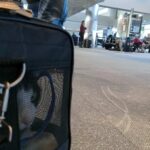Traveling by air can be an exciting experience, but navigating airport security can sometimes feel daunting. Understanding the Transportation Security Administration’s (TSA) rules regarding liquids is crucial for a smoother journey, especially concerning Travel Size Liquids. This guide breaks down everything you need to know about packing your toiletries and other liquids in your carry-on baggage, ensuring you breeze through security checkpoints.
The TSA’s primary rule for carry-on liquids is often referred to as the 3-1-1 rule. This regulation dictates that all liquids, aerosols, gels, creams, and pastes must be in containers of 3.4 ounces (100 milliliters) or less. These containers must then be placed in one quart-sized, clear, plastic zip-top bag. Think of common toiletries like shampoo, conditioner, lotion, toothpaste, and even liquid makeup – all these fall under this rule when carried on.
Why this rule? It’s a security measure designed to limit the quantity of liquids that passengers can bring onto airplanes in carry-ons, mitigating potential security threats. By consolidating these items into a single, transparent bag, TSA officers can efficiently screen them, speeding up the security process for everyone. Remember, adhering to these guidelines is not just about compliance; it’s about contributing to a safer and more efficient travel experience for all passengers.
Packing your travel size liquids correctly is key. Start by gathering all your liquid toiletries and cosmetics. Invest in reusable travel-size bottles if you don’t already have them. These are readily available and allow you to decant larger products into TSA-compliant sizes. When packing your quart-sized bag, ensure items fit comfortably and the bag can be sealed properly. Overstuffing can lead to delays at security.
Beyond the standard 3-1-1 rule, there are important exemptions to be aware of. Medically necessary liquids and medications, for instance, are generally exempt from the travel size liquids rule and the quart-sized bag requirement. However, it’s crucial to declare these items to TSA officers at the checkpoint for separate screening. Similarly, baby formula and breast milk are also typically allowed in reasonable quantities, even if they exceed the 3.4-ounce limit. Always be prepared to present these items for inspection and be ready to answer any questions from TSA personnel.
For travelers on inbound international flights with connecting flights within the United States, there’s a specific exemption regarding duty-free liquids. If you’ve purchased duty-free liquids internationally, exceeding 3.4 ounces or 100 milliliters, they may be permitted in your carry-on under specific conditions. These liquids must be in a secure, tamper-evident bag provided by the retailer. The bag must be transparent, show no signs of tampering, and you must have the original receipt showing purchase within the last 48 hours. Even with these secure bags, TSA may still screen the liquids, and any item that cannot be cleared will not be allowed in your carry-on. It’s generally recommended, even for duty-free purchases, to pack larger liquids in checked baggage whenever possible to avoid any potential issues.
In conclusion, understanding and adhering to the travel size liquids rule is essential for smooth airport security experiences. By packing your liquids in containers of 3.4 ounces or less and placing them in a quart-sized bag, you’ll navigate security checkpoints with greater ease. Remember to declare any exemptions like medications or baby formula and be aware of the specific rules for duty-free liquids on international flights. Planning ahead and packing smart ensures a less stressful start to your travels.
